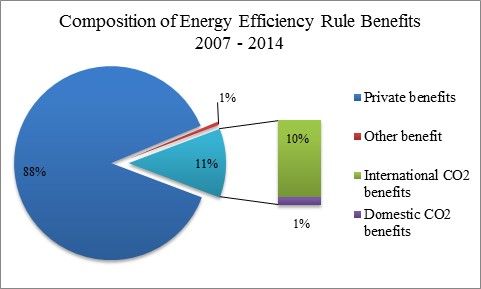Sofie E. Miller
American consumers may not be aware that, over the past decade, government agencies have issued a spate of new regulations establishing costly energy efficiency standards for household and commercial appliances. The Department of Energy (DOE) has recently finalized energy conservation standards for residential dishwashers, microwaves, clothes washers, furnaces, and air conditioners, appliances that most households rely on for everyday tasks.
Examining the Rationale
Each of these regulations increases the price of appliances in return for reducing long-term energy usage and energy bills. Due to the scope of these rules, it is important to examine the rationale that regulators use to justify them.
In a recent working paper, I examine DOE’s rationale for justifying its energy efficiency standards by measuring the types of the benefits that DOE claims result from its rules. The analysis examines 25 energy efficiency standards for appliances finalized between 2007 and 2014, and explains the ramifications of including private benefits and benefits to citizens of other countries in a traditional benefit-cost analysis.
Whose Benefits Are They, Anyway?
DOE relies on two types of regulatory benefits to justify its regulations: private benefits to consumers from reduced energy expenditures, and the international benefit of reductions in emissions of CO2.
In the past decade especially, federal regulators have cited behavioral economics and “consumer irrationality” to justify standards that limit the amount of electricity and water that appliances can use. “Private” benefits are the cost savings consumers are estimated to enjoy over the life of a more energy efficient appliance, which can offset the price increases and regulation causes. Because this cost saving is a benefit felt exclusively by the private consumer or business, rather than society at large, the benefits that justify DOE’s energy efficiency rules are “private benefits” rather than public benefits.
The paper finds that DOE estimates that efficiency standards issued between 2007 and 2014 will result in $26.63 billion in annual benefits. $23.4 billion—88%—of these are private benefits, and the remaining $3.2 billion are public benefits. Without the $23 billion in private benefits, the costs of these standards outweigh the benefits by $4.6 billion (2010$) annually.
Domestic Costs, Global Benefits
The next largest category of regulatory benefits is international benefits from CO2 reductions, which provide $2.75 billion in annual benefits, or 10% of total benefits.
DOE relies on the Social Cost of Carbon (SCC) to value reductions in CO2 emissions as a result of its rules. Importantly, the SCC is calculated using a global value for reducing domestic emissions. While the costs of the standards will be borne by the American consumers and businesses that are directly affected by the rule, the reduction in carbon emissions resulting from DOE’s rules is monetized based on its global, rather than domestic, value.
Longstanding federal guidelines direct agencies to focus their regulatory analyses on the costs and benefits felt by U.S. residents. In the case of DOE energy efficiency rules, this would limit DOE to considering benefits to U.S. residents who purchase higher-priced appliances—however, DOE is not relying on the principles of standard benefit-cost analysis in its rulemakings. As examined above, 90% of the benefits of CO2 emissions reductions—and 10% of total regulatory benefits of these rules—accrue to residents of other countries.
If we limit standing to residents of the U.S., the costs of these regulations outweigh the public benefits by $7.38 billion annually.

The reliance on private and international benefits differentiates energy efficiency rules from the majority of federal regulations, which have historically relied on public, domestic benefits—such as reduced externalities—for justification. However, our analysis finds that the private benefits of DOE’s efficiency rules dwarf the anticipated public benefits, such that most of these rules would not pass a benefit-cost test if relying on domestic externality benefits alone.
The questionable legitimacy of selectively including international benefits and such surprisingly large private benefits casts doubt on whether the recent enthusiasm for appliance efficiency mandates really benefits Americans.

